Newsletter: GL Announces Protocol Analysis / Emulation for T3 E3 Transmission Systems
Welcome to the January 2009 issue of GL's Newsletter providing information on our latest T3 E3 Protocol Analysis and Emulation Software that runs on GL's USB Based T3 E3 Analyzer.
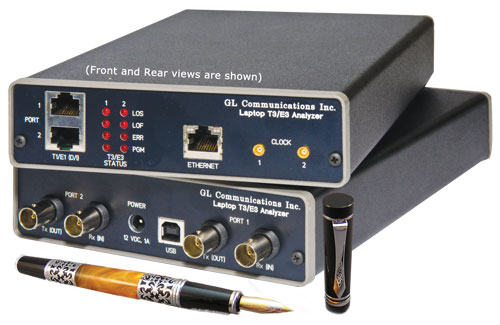
A brief description of T3 E3 Protocol Analyzer and Emulator is given below:
PPP Protocol Analyzer for T3/E3
The PPP Analyzer captures a host of PPP protocols exchanged between the two nodes over T3/E3 links and provides useful analysis, which includes distribution of protocols, protocol fields, frame lengths and frame status. User can obtain detailed analysis of the protocol and can gather various statistics and measurements.
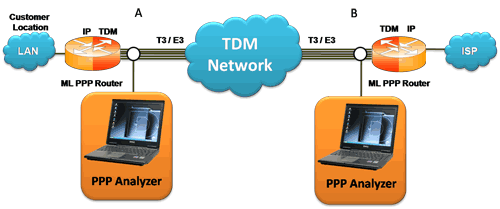
Some of the important features:
- Supports a host of protocols including PPP, IPCP, BCP, BPDU, PAP, CHAP, HTTP, SNMP, STUN, FTP, DNS, and DHCP
- Ability to test and perform numerous measurements across WAN- LAN or LAN-LAN connection
- Ability to test and analyze HDLC based PPP protocol in synchronous environment
- Search and filtering capabilities for both real-time as well as offline analysis.
- Provides Summary, Detail, Statistics, and Hex dump views.
- Summary view provides the information about few important fields (Dev #, Layer 3 Protocol, LCP message type and higher protocol specific information like Destination and Source IP address, Destination and Source TCP as well as UDP port details, HTTP/FTP message type, and so on).
For comprehensive information on the product, please refer to T3 E3 PPP Protocol Analyzer web page.
ATM Protocol Analyzer for T3
GL's T3 ATM Analyzer is used to analyze and decode different ATM protocols like ATM, AAL2 Protocols (CPS-SDU, SSSAR-SDU, and SSCS), AAL5 (CPCS), UNI and others across U plane and C plane of UNI and NNI interface.
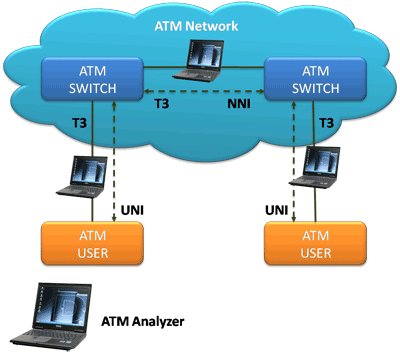
Some of the important features:
- Displays Summary, detail, hex-dump, statistics, and call trace views
- Summary View displays Dev #, Frame #, VPI/VCI, PT (Payload Type), HEC, OSF, AAL Type, Frame Type, CID, LI, CPI, UUI, SSSAR CID and SSCS message type etc
- Detailed view displays decodes of user-selected frames
- Hex dump view displays raw frame data as hexadecimal and ASCII octet dump
- Statistics view displays statistics based on frame count, byte count, frames/sec, bytes/sec etc for the entire capture data
For comprehensive information on the product, please refer to T3 ATM Protocol Analyzer web page.
Frame Relay Protocol Analyzer for T3 E3
Frame Relay is another commonly used data link protocol based on packet switching technology. It is mainly incorporated into corporate data networks due to its cost-effective data transmission, and flexible bandwidth.
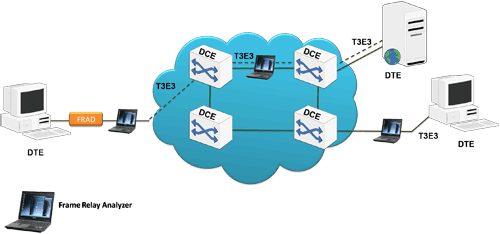
GL's T3 E3 Frame Relay Protocol Analyzer can be used to analyze and decode frames conforming to Q.921, Q.922, LAPF, Frame Relay Forum standard - FRF.9 and FRF.12, Multiple Protocol Encapsulation, LCP RFC1661, Q.933 SVC and LMI SNAP, PPP, IP, SMTP, POP3 and so on.
Some of the important features:
- Supports decoding of encapsulated protocols, and long frames up to 16 Kbytes.
- Analyze Permanent Virtual Connection (PVC) and Switched Virtual Connection (SVC) frames
- Supports filtering and search features based on LAPF parameters and Q.933 layer parameters such as DLCIs, Message Type, FECN, BECN, DE, NLPID's TCP, IP, SMTP, POP3, and so on.
- Provides Summary View, Detail View, Hex dump, statistics, and call trace views.
- Summary view displays LAPF information like DLCI, FECN, BECN, Q.933 Message Type, IP address, TCP/UDP port address etc.
For comprehensive information on the product, please refer to T3 E3 Frame Relay Protocol Analyzer web page.
HDLC Protocol Analyzer / Emulator for T3 E3
The HDLC protocol is a data link layer used for transmitting data between called nodes. The HDLC protocol embeds information in a data frame that allows devices to control data flow and correct errors. A frame of data is encapsulated by flags. The beginning and end of an HDLC frame are marked by flag characters - 01111110 binary.
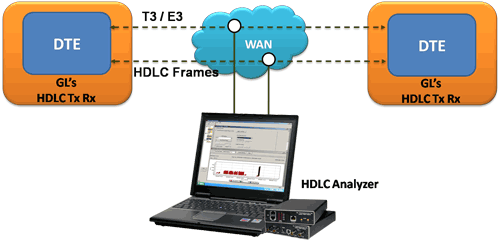
GL's T3/E3 HDLC protocol analyzer provides the capability to capture, and analyze HDLC data on a T3/E3 lines. There may be a single data channel per T3/E3 line. After setting the T3/E3 ports and FCS type and starting the decoding process, the main screen displays the captured HDLC frames. Flags are stripped, and all other data is presented, including FCS bytes.
In addition to HDLC Analyzer, T3/E3 analyzer supports HDLC Tx Rx Test application that further helps in transmitting and capturing pre-defined HDLC frames. It generates frames in memory and fills them with 64 bit sequential integer numbers. The number is either truncated if the frame length is less than 8 bytes or the same number bytes are concatenated to make up the complete frame. At the end of each frame a Frame Check Sequence (FCS) is generated to verify the data integrity on the receive side.
Some of the important features:
- Displays Summary, detail, hex-dump, statistics, and call trace views
- Summary view displays device#, frame#, LAPD, LAPF specific information and IP information like source/destination IP address, TCP source port, TCP destination port etc
- Detailed view displays decodes of user-selected frames
- Statistics view displays statistics based on frame count, byte count, frames/sec, bytes/sec etc for the entire captured data
- Hex dump view displays the frame information in HEX and ASCII format
For comprehensive information on the product, please refer to T3 E3 HDLC Protocol Analyzer web page.
 Back to Latest News Page
Back to Latest News Page